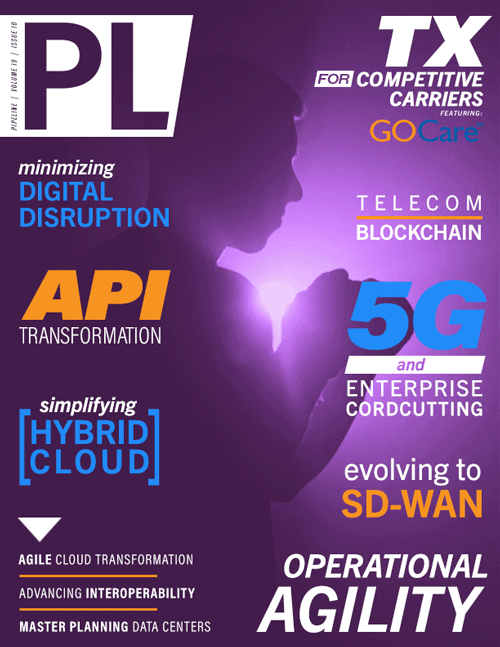Agility of networks: changing & using
resources dynamically

Cognition is the process of acquiring and understanding data and information and producing new data, information, and knowledge. This means that the knowledge of a Cognitive Network increases and becomes more accurate with experience. It can understand the significance of changing telemetry, reason about what caused those changes, and reconfigure resources dynamically at runtime to protect existing services and/or offer new services. A Cognitive Network thus bases its decisions on changing user needs, business goals, and network conditions, and learns experientially from its own decisions as well as those of the operator. Given a set of goals, a Cognitive Network can dynamically optimize network resources to provide a set of services that both meets user needs and the business goals of the Operator.
As technology becomes increasingly complex, managing telecommunications infrastructure grows accordingly in complexity. Operators need data-driven, context-aware tools to help them make the right decisions at the right time. This enables actionable decisions to facilitate prompt adaptation to various business and operational needs.
The main objectives of the ETSI agile cognitive work are listed as:
- To develop standards for a Cognitive Network Management system, incorporating a set of closed control loops. The closed control loops are based on extensions to the “observe-orient-decide-act” model (e.g., the incorporation of situation awareness, learning, and reasoning capabilities).
- To adapt the usage of available network resources and services of the managed system using Cognitive Management. This enables the real-time evolution of user needs, environmental conditions, and business goals to determine which services should be offered during a given context.
- To define how cognitive management can use different types of policies (e.g., imperative, declarative, and intent) to specify adaptive behavioral changes.
- To develop standards that define a model-driven architecture using cognitive management to provide the required Operator Experience.
The agile cognitive system is an experiential architecture—it learns through experience. This self-learning principle improves operator experience and enables the system to adjust the offering of services in response to contextual changes.
Agile Cognitive Principles
The agile Cognitive Management Functions are based on an innovative cognition model. A cognition model defines how cognitive processes, such as comprehension, action, and prediction, are performed and influence decisions. The agile cognition model draws heavily on how human cognition is performed. The perception portion provides the notion of classifying data into pre-defined representations that are understood and relevant to the current situation; memory is used to increase comprehension of the situation; and actions are judged by how effectively they perform to support the situation.
Agile Cognitive Management learns from experience to improve its performance. Agile Cognition Management is based on human cognition. Cognitive psychology defines three interacting layers, called reactive (or subconscious), deliberative, and reflective. Reactive processes will take immediate responses based upon the reception of an appropriate external stimulus. In humans, these processes correspond to instinctual and learned behaviors.Knowledge Management, Context-Aware Management, Cognition Management, and Situational Awareness Functions perform all or part of these tasks. The purpose of this part of the control loop is to ensure that input data and information is adapted to the current context and situation. Inferencing discovers more about the nature and meaning of the data. Situational processing analyzes the information to determine if anything has just occurred that threatens its system goals. If problems are identified, then situational processing decides what is likely to happen, and how that affects the goals that the system is trying to achieve. This produces a set of possible alternative actions.
The Cognition Management
Cognition Management uses existing knowledge to validate and generate new knowledge. This means that new knowledge may be added, and in some cases, existing knowledge may be changed. A cognition framework uses multiple diverse processes and technologies, including linguistics, computer science, AI, formal logic, neuroscience, psychology, and philosophy, along with others, to analyze existing knowledge and synthesize new knowledge.
The Agile Cognition Process
An agile cognitive system is based on how humans think. A cognitive system is a system that can reason about what actions to take, even if a situation that it encounters has not been anticipated or seen before. A cognitive system can learn from its experience to improve its performance. It can also examine its own capabilities and prioritize the use of its services and resources. In addition, it is able to explain what actions it took and accept external commands to perform necessary actions.
Situational Awareness
Situational Awareness enables the agile cognitive system to be aware of events and behavior that are relevant to a set of entities in the system being assisted and/or governed), and how those events and behavior affect the achievement of the current set of goals that are being worked on by the agile cognitive system. This includes the ability to understand how recommendations and commands given by the agile cognitive system impact the current set of goals, both immediately and in the near future. Situation awareness is especially important in environments where the information flow is high, and poor decisions have the possibility to lead to serious consequences (e.g., violation of Service Level Agreements).
A cognitive system is a system capable of independently developing strategies for and solving human tasks. A cognitive system is both context- and situation-aware. It may draw on multiple sources of information, including both structured and unstructured



















